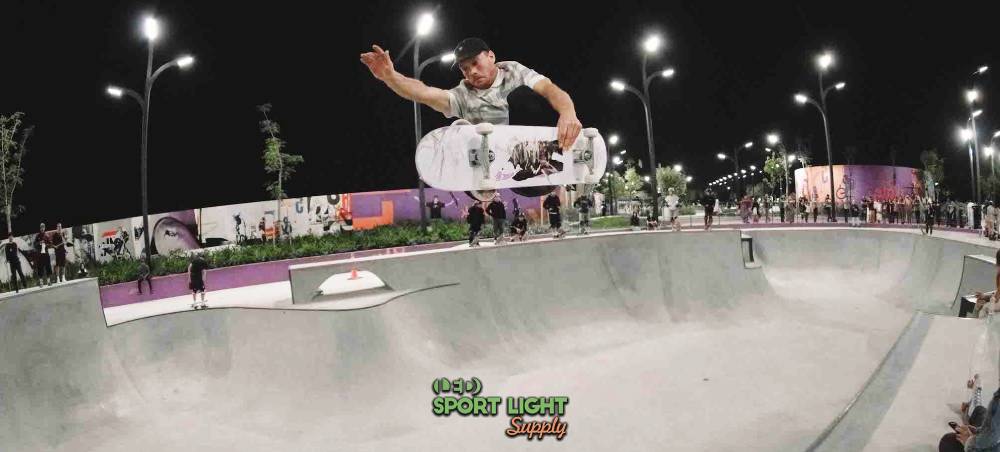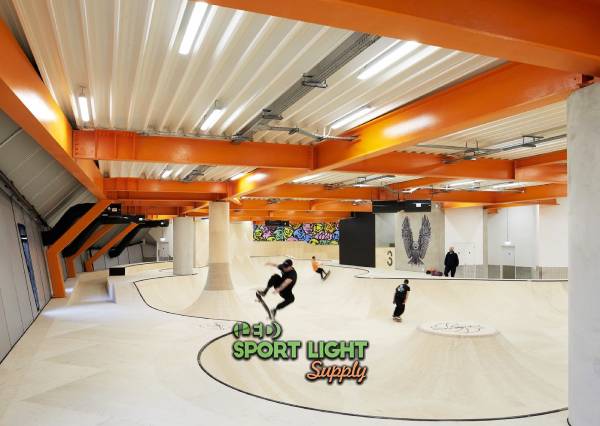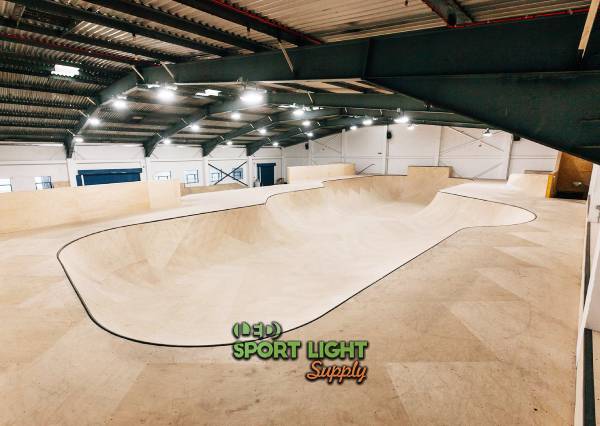Skateboarding made its debut in the Summer Olympics in Tokyo 2020, showcasing the sport’s global appeal and growth. As with any major sporting event, the right environment is essential to ensure athletes perform at their best. In the case of skateboarding, where action happens quickly and in dynamic forms, lighting design plays a major role in creating the perfect conditions for both the athletes and the audience. The lighting needs to be flexible and adaptable, matching the excitement and energy of skateboarding while offering visibility and safety to all participants. In this exploration, we look at dynamic lighting solutions tailored to Olympic skateboarding arenas, addressing various technical and design considerations.
Table of Contents
ToggleUnderstanding Lighting Requirements for Skateboarding Arenas

Skateboarding is an action-packed sport that requires a specific type of lighting to maximize performance and audience engagement. Unlike traditional sports played on flat surfaces, skateboarding arenas are filled with ramps, bowls, and rails that require a lighting setup that highlights the athletes’ movements without casting too many shadows or creating distractions. Proper illumination ensures that the athletes’ performances are clearly visible, both on television and to the audience in the arena.
| Factor | Requirement |
|---|---|
| Minimum Lux Level | 1000 lux (general), 1500 lux (larger or night-time events). |
| Street Events Lux | 1000-1500 lux for obstacles (rails, stairs, ledges). |
| Park Events Lux | 1500+ lux for ramps and bowls, especially for aerial tricks. |
| Uniformity of Light | Even distribution to prevent shadows and glare. |
| Indoor Arena | Focused lighting, fewer but powerful fixtures. |
| Outdoor Arena | Multiple fixtures to cover large areas. |
| Daylight Events | Natural light + artificial lighting as needed. |
| Night Events | 1500+ lux for full visibility at night. |
| Street Skateboarding | Focus on obstacles, no glare. |
| Park Skateboarding | High lux for ramps and bowls. |
| Lighting Fixtures | Energy-efficient LEDs, adjustable color temperature. |
| Lighting Distribution | Even light across all areas. |
| Glare Prevention | Shielded fixtures to avoid glare. |
| Weather Impact | Outdoor venues must use durable fixtures for weather conditions. |
| Energy Efficiency | Use LEDs for lower energy consumption. |
| Safety & Accessibility | Clear visibility for athletes and audience. |
Lux Requirements for Skateboarding Arenas
 Lighting design for skateboarding competitions is essential for ensuring that athletes are visible to both the audience and the cameras, while also minimizing safety risks. Lux, which measures the intensity of light received on a surface, plays a vital role in achieving the desired visual effect. This measurement of illuminance indicates how much light is distributed across a specific area, and it is crucial that lighting meets certain lux levels based on the type of activity, venue size, and specific event requirements. The International Olympic Committee (IOC) has established certain guidelines for lux levels, and lighting designers must adhere to these in order to create the ideal environment for both athletes and spectators.
Lighting design for skateboarding competitions is essential for ensuring that athletes are visible to both the audience and the cameras, while also minimizing safety risks. Lux, which measures the intensity of light received on a surface, plays a vital role in achieving the desired visual effect. This measurement of illuminance indicates how much light is distributed across a specific area, and it is crucial that lighting meets certain lux levels based on the type of activity, venue size, and specific event requirements. The International Olympic Committee (IOC) has established certain guidelines for lux levels, and lighting designers must adhere to these in order to create the ideal environment for both athletes and spectators.
Lux Levels for Skateboarding Events
In Olympic skateboarding competitions, the minimum lux level for adequate visibility is typically set at around 1000 lux. This ensures that the athletes’ movements and their equipment are sufficiently illuminated, which is particularly important for high-definition broadcasts. With this lighting level, both the athletes and the action are clearly visible from every angle, which is essential for the viewing experience. However, depending on the specific type of skateboarding event and the venue’s requirements, the lux level may need to be higher. For example, in street skateboarding events, the lighting should be sufficient to highlight obstacles such as rails, stairs, and ledges. In park skateboarding, which features ramps and bowls, more intense lighting may be required to ensure visibility, especially when athletes perform aerial tricks.
For larger venues or outdoor settings, lighting may need to be increased to around 1500 lux or more. These settings are typically used during nighttime events or in indoor arenas, where the natural light may not provide enough illumination. Night-time competitions or those held indoors without sunlight require brighter lighting to guarantee that every detail of the competition is visible to both the audience in the stadium and the television viewers.
Uniformity and Consistency in Lighting Distribution
In addition to achieving the required lux levels, uniformity in lighting distribution is an important factor in skateboarding event lighting. An evenly distributed light spread ensures that the entire skateboarding area, including ramps, rails, and obstacles, is well-lit and free from large, distracting shadows or excessively bright spots. Uneven lighting can cause visual distortion, potentially leading to difficulty in judging the athletes’ movements or the execution of tricks. Lighting fixtures must be carefully placed to ensure the light is distributed uniformly across the skateboarding area. This includes considering how light interacts with various surfaces and obstacles, such as ramps and ledges, as these elements play a major role in the athlete’s performance.
Factors Influencing Lighting Design
 Various factors influence the design of lighting systems for Olympic skateboarding arenas. Among the most important of these factors are the size and layout of the venue, the location of the event (whether indoors or outdoors), the timing of the event, and the specific type of skateboarding event. Each of these variables plays a role in determining the lighting solutions required for optimal performance and visibility.
Various factors influence the design of lighting systems for Olympic skateboarding arenas. Among the most important of these factors are the size and layout of the venue, the location of the event (whether indoors or outdoors), the timing of the event, and the specific type of skateboarding event. Each of these variables plays a role in determining the lighting solutions required for optimal performance and visibility.
Venue Size and Layout
The overall size and layout of the arena are fundamental considerations when designing a lighting setup. Large outdoor arenas, such as those used for Olympic skateboarding, require a complex lighting network to cover the entire area. To achieve this, multiple fixtures must be installed and positioned in such a way as to provide an even spread of light across the whole venue. This often includes lighting mounted on tall poles or structures that can cast light on large sections of the arena, ensuring that no area is left under-illuminated.
The layout of the skateboarding arena also influences lighting placement. Large skateboarding parks may have a range of features such as bowls, ramps, and stairs that require individual attention. These features need to be illuminated without creating any glare or dark spots. In contrast, smaller indoor venues allow for more precise and targeted lighting since they can more easily accommodate fewer fixtures. Because the lighting does not need to compete with natural light in indoor environments, the fixtures can be optimized for the immediate skateboarding space.
Time of Day or Night
The time of day or night that the event takes place has a direct impact on the lighting needs of skateboarding arenas. Events held during the day may benefit from some natural sunlight, but for competitions held in the evening or at night, the lighting requirements are far greater. The transition from daylight to darkness requires an increase in artificial lighting levels to ensure that the action remains visible, especially when trick performances take place at heights or at distances from the audience. The ambient light levels outside the venue also need to be considered, as lighting solutions must compensate for any potential loss of natural light once the sun sets.
Lighting Needs for Different Skateboarding Events
The specific requirements for lighting can also change depending on the type of skateboarding event. Different events, such as street skateboarding and park skateboarding, each present unique challenges that must be addressed in the lighting design.
Street Skateboarding
In street skateboarding, athletes perform tricks on a variety of urban elements like rails, ledges, and stairs. To properly light these obstacles, designers must ensure that the lights focus on these specific features without causing glare. The lighting needs to follow the athlete’s movement and highlight obstacles at the correct angles. As street skating often involves a greater range of motion and unpredictability in movement, the lighting system must be flexible enough to accommodate these dynamics while ensuring that no critical features are missed.
Park Skateboarding
Park skateboarding involves larger structures such as ramps and bowls, where athletes often perform aerial tricks and jumps. In this type of skateboarding, lighting must be designed to focus more intensely on the ramps and bowls to guarantee high visibility during complex maneuvers, especially when athletes are airborne. For optimal visibility, designers may need to use more powerful light fixtures to illuminate these elevated areas, ensuring that every angle of the athletes’ performance is visible both to the spectators and the broadcast cameras.
For both types of events, the lighting must ensure that the athletes are clearly visible without creating distracting shadows or harsh glare. In addition to this, some level of lighting customization may be necessary, such as adjusting light intensity or color, to suit different moments during the competition or specific phases in the event.
Dynamic Lighting Effects for Skateboarding
Dynamic lighting design is one of the most important aspects of enhancing the experience of Olympic skateboarding competitions. The lighting must not only be functional but should also create an engaging atmosphere for spectators. The use of color, movement, and intensity variations in lighting can add energy and excitement to the event, keeping viewers engaged and enhancing the spectacle.
Adaptability to Different Phases of Competition
A major component of dynamic lighting in skateboarding events is adaptability. Lighting solutions must adjust to different phases of competition. For example, in the early rounds, the focus might be on creating a neutral, bright lighting environment that allows athletes to perform safely and consistently. However, as the competition reaches its climax, lighting can evolve into more dramatic effects to heighten the drama and excitement of the final rounds.
During critical moments, such as when a skateboarder is attempting a particularly difficult trick, lighting can shift in intensity or color to accentuate the action. Bright, concentrated beams can follow the athlete’s movements, and the lighting around the arena can dim to maintain focus on the skater.
Synchronizing Lighting with Music and Crowd Energy
Another consideration for dynamic lighting in skateboarding events is the synchronization of lighting with music and crowd energy. Skateboarding is a highly energetic sport, and lighting effects that change with the beat of the music can enhance the overall experience. Lights that flash, pulse, or change color in response to crowd reactions or sound can help amplify the excitement of the moment.
Lighting designers can work with event organizers to create a coordinated lighting system that responds to various moments in the competition, adjusting in real-time to match the intensity and emotion of the event. This approach allows the lighting to become an active part of the overall experience, rather than just a passive element supporting the action.
Customizable Lighting for Different Conditions
Flexible, customizable lighting options are essential for ensuring that the arena is suitable for various times of the day or different environmental conditions. For outdoor venues, sunlight during the day can alter the overall lighting requirements, while nighttime events will need more powerful artificial lights. During outdoor events, lighting solutions must be adaptable to changing weather conditions, including rain, wind, or heat.
At the same time, indoor arenas require lighting that can be adjusted based on the size and structure of the venue. The lighting system should be able to change in real-time to ensure that it remains suitable for any given event, from practice sessions to finals.
Technical Considerations for Skateboarding Arena Lighting
Effective lighting design is not only about creating the right aesthetic and mood; it must also address practical considerations, such as energy efficiency, cost, and safety.
Energy Efficiency
With the growing emphasis on sustainability, energy-efficient lighting systems have become a priority in many Olympic sports venues. LED lighting has become a popular option in skateboarding arenas due to its high efficiency and long lifespan. LED lights consume less power than traditional lighting solutions, reducing both operational costs and the environmental impact.
Additionally, LED fixtures generate less heat, making them a safer option for both athletes and spectators. They can also be customized to provide various color temperatures, ensuring that the lighting matches the specific mood or requirements of the competition.
Safety and Accessibility
Safety is always a priority in any sporting event, and lighting design plays an important role in ensuring that skateboarding events are safe for participants and spectators alike. Inadequate lighting can cause confusion or misstep, leading to potential accidents. By ensuring that all obstacles, ramps, and rails are well-lit and free from shadows, lighting design can help minimize risks.
For spectators, accessibility to good viewing positions must be accounted for in the lighting layout. The light distribution should consider all areas of the venue to guarantee that everyone in the arena can clearly see the action. At the same time, emergency lighting systems should be incorporated to ensure safe evacuation in case of an emergency.
Maintenance and Longevity
Skateboarding events often require lighting that is reliable and can withstand heavy use. Given the frequent movement of the fixtures and changing lighting effects, designers must use high-quality materials that can stand up to wear and tear. Regular maintenance schedules should also be considered to ensure that all lights function optimally throughout the event.
Final Thoughts on Dynamic Lighting for Skateboarding
As skateboarding continues to grow as an Olympic sport, lighting solutions will play an increasingly important role in shaping the viewer experience. From meeting the technical requirements of lux levels to creating dynamic, adaptive lighting effects, designers have a variety of options to explore when it comes to illuminating Olympic skateboarding arenas.
The emphasis should be on creating an environment where athletes can perform their best, while also ensuring that spectators have a memorable experience. By combining practicality with creative lighting techniques, designers can contribute significantly to the overall atmosphere of the event.
